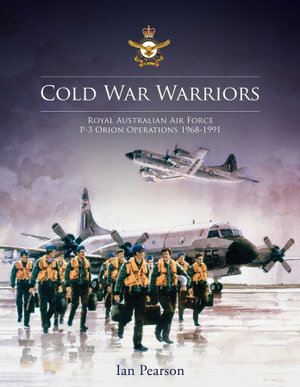
Cold War Warriors: Royal Australia Air Force P-3 Orion Operations 1968-1991. By Ian Pearson. Big Sky Publishing 2021
Reviewed by Mark Bailey PhD
There is a pattern to the broad historiography of war and warlike operations: the first generation histories are the stories of those who were there. These are critical. They tend to set the tone of the historiography and they provide the foundation for it.
Second generation histories are written when the bulk of operational and lower-level classified details are released and historians begin to assess what occurred from these sources. The third comes when the once highly classified details are finally released. This can be many decades after the events occurred. This general pattern also applies to peacetime operations (or warlike operations in peacetime), but the historiography of peacetime operations tends to be more ‘patchy’ than wartime historiography for many reasons. Among these are that ‘those who were there’ regard their normal peacetime activities as routine and uninteresting. The former may be true, the latter is not.
Therefore it is immensely refreshing to see an important new work like Cold War Warriors. The Cold War was a strategically critical event in post-WWII history, forming much of the post-WWII era and ending only over the period 1989-1991 with the collapse of the USSR. Cold War Warriors is somewhat more than a first-generation history, although it tells the stories of those who were there.
The book itself is very well printed on high-quality stock. This is reflected in the quality of the plentiful illustrations. Of special note is that many of these are from private collections of ‘those who were there’, and this shows occasionally in lower quality image (p.131, p. 241), yet these images are among the more valuable, often showing things not normally covered by official photography. They also personalise the work.
The story told is near-entirely unknown to the public. The best-known extant history of the P-3 is Stewart Wilson’s 1991 Catalina, Neptune and Orion in Australian Service. Cold War Warriors is a vastly more comprehensive work and focusses instead on the publicly-unknown operational history of the RAAF P-3 force during the Cold War. The driver for their acquisition was the deterioration in Australia’s strategic circumstances from the early 1960s with the growth of the Soviet Navy. The capability acquisition phase is well covered. The story of the aircraft is covered in logical sequence, Part 1 covering acquisition, Part 2 the consolidation and entry-into-service period, and Parts 3 and 4 the routine operations of the P-3B and P-3C fleets. The chapters within these parts start with an overview of the year, this is very useful in maintaining the flow of the narrative. The careful interweaving of first-hand accounts, strategic circumstances and 92 Wing operations is exemplified in Chapter 19 and the story of the loss of 754 at Cocos Island in April 1991 (pp.382-393).
More than just a ‘book for the public’ Cold War Warriors also represents ADF corporate memory. It tells of how a crucial national capability was developed over three decades. This is a work of interest not only to a public readership but also to RAAF and Navy mobilisation planners.
The book reveals much about the strategic importance of 92 Wing’s Operation Gateway from Butterworth, Malaysia that tells the little-known story of the operations by the Royal Australian Air Force’s P-3 Orions during the Cold War. The maritime patrol aircraft (the Lincoln and Neptune history is sketched in Chapter 1) had a low profile, operated far offshore and were routinely classified. Ian Pearson has accessed declassified documents (but not to all of the highest levels); this and the personal histories have deeply enriched the book.
In many ways, Cold War Warriors is an introductory book to what should (hopefully) be a series. While much of 1992 – 2002 activities will remain unavailable due to classification issues, much can still be told, further deepening the historiography of this nationally critical maritime capability. The same will be true of the AP-3C era 2002 onwards. As a small disclaimer, the reviewer was an intelligence officer with 92 Wing and also at Detachment A (Butterworth) 1996-2001 during the era when the P-3C and the developing AP-3C force attention was firmly focussed on national and regional tasks.
Any ANI members with an interest in the totality of Australian maritime operations during the Cold War will find Cold War Warriors to be an important addition to their libraries, informing them as it does of an aspect of Australian maritime operations which has simply been unknown to this point. Of note, a second print run is about to be distributed. This is one of the occasions when the reviewer will be purchasing copies for mobilisation planning purposes, and for distribution to US academic and retired naval contacts.



